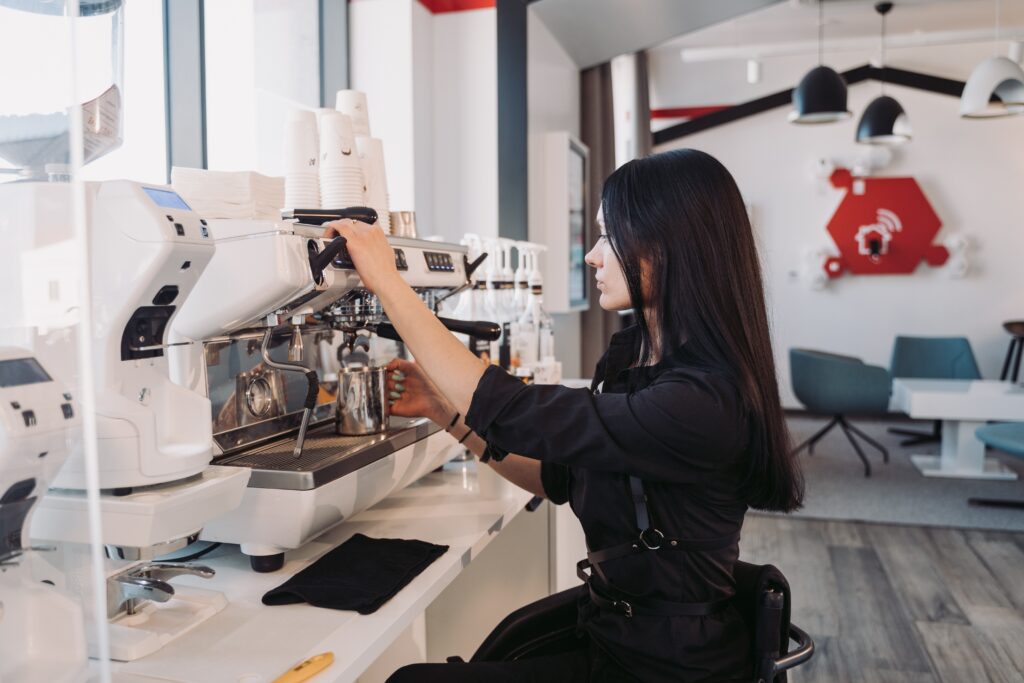
Modern coffee shops are ground zero for low-pressure social activity for people of all ages, creeds, and backgrounds. However, as the industry dominates in cities across the world, from small independents to the likes of Starbucks, each coffee shop must individually meet the demand for accessibility requirements that their disabled customers depend on to even get through the entrance comfortably.
So today, on the Direct Access blog, we’re going to answer this question and talk about how you can transform your coffee shop into a more inclusive, accessible, and user-friendly environment.
When designing the layout of your coffee shop, it is naturally important to consider the journey of your customer, which usually begins at the front entrance. So, you should ask yourself, could a wheelchair user make it through the front door without assistance? Is the door wide enough? Is there a ramp, or by contrast, a step-in-place that would navigation difficult? Generating solutions to these problems is key and can easily determine whether a wheelchair user will look at your business and become an alienated passer-by or a curious customer.
There are other physical elements beyond the door itself that are crucial to a comfortable beginning of your customer’s journey, like whether your outdoor signage and iconography are clear, easy-to-understand, and sufficiently color-contrasted. The latter is especially important for people with low vision while having clear iconography and imagery is massively helpful for people with learning difficulties.
Alongside this – try to simplify your menus. Although most coffee shops favor extravagant names for their coffees, an overcomplicated menu is detrimental to both the business and the customer. Premium coffee shops are often guilty of this and fall short of providing accessible descriptions of their products by favoring unclear language. Think also about the formats you provide your menu in, such as large print, braille, easy read, and accessibility of your digital menus. A big display behind the counter will not be appropriate for blind users.
The next step of the customer’s journey involves navigating the main space of the store. Ensuring that the floor plan is spacious and spread out is important not only for mobility-impaired users but also makes your shop feel less claustrophobic overall. When it comes to your furniture, favoring easily movable chairs is a clear choice for accessibility over bulky armchairs as these would also allow wheelchair users to get to their tables without issue.
You may have noticed that many of the changes that we have noted so far are small and inexpensive. Compared to the return you can expect to see when creating an inclusive social environment, the monetary cost of putting accessibility at the forefront of your design is pennies by comparison.
A more significant altercation, but, nonetheless, crucial one, is providing lower counters for people of short stature and wheelchair users. This will give them greater access to paying on wired card readers, as well as easier access to products on the counter such as cakes and cookies.

Also, consider your choice of music and the volume as this can create a confusing array of noise for people with hearing aids. On that – be sure to include a hearing loop microphone on your counter so Deaf people can interact with your barristers.
Providing an accessible toilet (not adjacent to or near a customer’s table) is also crucial, as is ensuring that an emergency alarm if a mobility-impaired customer experiences a fall is fitted.
An appropriately designed handrail to further aid transference for wheelchair users is also essential, and it must be produced with materials that are accessible to those with cold hypersensitivity. For further information on how to design accessible restrooms, we advise reading one of our previous blogs.
Table service became frequent in the wake of the COVID-19 pandemic, and in terms of accessibility, this remains an important service that coffee shops should provide. Picture a wheelchair user trying to maneuver in a bustling coffee shop to their table while also carrying a steaming hot coffee.
Although we believe that true accessibility means creating a barrier-free experience where the capabilities of the individual are equal and without compromise, this is a circumstance where the safety of a customer could be in danger, and therefore providing table service is not only appropriate but could also be an opportunity to display the situational adaptability and friendliness of your staff.
There is a multitude of other adaptations you can make to your coffee shop to make it accessible, such as with your digital accessibility; advertising the measures you’ve taken to be inclusive on your online platforms, with menus and other information translated into formats that can be interpreted by sign language users.
Providing water points for service dogs, opting for cups that are easy to grip and handle for individuals with dexterity impairments, and teaching your internal staff and external recruits about the necessity for these measures are further changes you can make that many coffee shops don’t often consider.
As all organizations should, it is also important to be mindful of the needs of your employees and make your recruitment process inclusive. This can be achieved by making reasonable adjustments during the application, submission, and enrolment process to suit potential staff members who might also be disabled people. Not only will this massively expand your pool of potential applicants, but providing for disabled people will also massively increase your customer base and boost your coffee shop’s public image.
Coffee shops, after all, are refuges for comfort drinks, and showcasing the fact that you acknowledge the diversity of people in our society will surely reflect in the number of customers you will have.